Assessing Skin Photoprotection in the Infrared Range: The Reflectance Profiles of Cold-Pressed Plant Oils
Abstract
1. Introduction
- α = absorbance;
- ρ = reflectance;
- T = transmittance.
2. Materials and Methods
2.1. Materials
2.2. The Course of the Measurements
2.3. The Statistical Analysis
3. Results
3.1. Analysis of the Directional–Hemispherical Reflectance
3.1.1. The Spectral Range of 1000–1700 nm
3.1.2. The Spectral Range of 1700–2500 nm
3.2. Analysis of the Correlation Between the Directional–Hemispherical Reflectance of and the Compounds in the Oils
4. Discussion
5. Conclusions
Limitations of This Study
Author Contributions
Funding
Institutional Review Board Statement
Informed Consent Statement
Data Availability Statement
Conflicts of Interest
References
- Donya, M.; Radford, M.; ElGuindy, A.; Firmin, D.; Yacoub, M.H. Radiation in Medicine: Origins, Risks and Aspirations. Glob. Cardiol. Sci. Pract. 2014, 2014, 437–448. [Google Scholar] [CrossRef] [PubMed]
- Skotarczak, K.; Osmola-Mańkowska, A.; Lodyga, M.; Polańska, A.; Mazur, M.; Adamski, Z. Photoprotection: Facts and Controversies. Eur. Rev. Med. Pharmacol. Sci. 2015, 19, 98–112. [Google Scholar] [PubMed]
- Tyrrell, R.M. Modulation of Gene Expression by the Oxidative Stress Generated in Human Skin Cells by UVA Radiation and the Restoration of Redox Homeostasis. Photochem. Photobiol. Sci. 2012, 11, 135–147. [Google Scholar] [CrossRef] [PubMed]
- Omer, H. Radiobiological Effects and Medical Applications of Non-Ionizing Radiation. Saudi J. Biol. Sci. 2021, 28, 5585–5592. [Google Scholar] [CrossRef]
- Wang, M.; Charareh, P.; Lei, X.; Zhong, J.L. Autophagy: Multiple Mechanisms to Protect Skin from Ultraviolet Radiation-Driven Photoaging. Oxid. Med. Cell Longev. 2019, 2019, 8135985. [Google Scholar] [CrossRef]
- Saewan, N.; Jimtaisong, A. Natural Products as Photoprotection. J. Cosmet. Dermatol. 2015, 14, 47–63. [Google Scholar] [CrossRef]
- Sample, A.; He, Y.Y. Mechanisms and Prevention of UV-Induced Melanoma. Photodermatol. Photoimmunol. Photomed. 2018, 34, 13–24. [Google Scholar] [CrossRef]
- Lyons, A.B.; Trullas, C.; Kohli, I.; Hamzavi, I.H.; Lim, H.W. Photoprotection beyond Ultraviolet Radiation: A Review of Tinted Sunscreens. J. Am. Acad. Dermatol. 2021, 84, 1393–1397. [Google Scholar] [CrossRef]
- Hudson, L.; Rashdan, E.; Bonn, C.A.; Chavan, B.; Rawlings, D.; Birch-Machin, M.A. Individual and Combined Effects of the Infrared, Visible, and Ultraviolet Light Components of Solar Radiation on Damage Biomarkers in Human Skin Cells. FASEB J. 2020, 34, 3874–3883. [Google Scholar] [CrossRef]
- Fernández, E.; Fajarí, L.; Rodríguez, G.; Cócera, M.; Moner, V.; Barbosa-Barros, L.; Kamma-Lorger, C.S.; de la Maza, A.; López, O. Reducing the Harmful Effects of Infrared Radiation on the Skin Using Bicosomes Incorporating β-Carotene. Ski. Pharmacol. Physiol. 2016, 29, 169–177. [Google Scholar] [CrossRef]
- Kalemba-Drożdż, M.; Grzywacz-Kisielewska, A.; Cierniak, A. Surowce polifenolowe. Zastosowania i perspektywy (red). Oficyna Wydawnicza Kraków AFM 2022, 117–139. [Google Scholar]
- Solano, F. Photoprotection and Skin Pigmentation: Melanin-Related Molecules and Some Other New Agents Obtained from Natural Sources. Molecules 2020, 25, 1537. [Google Scholar] [CrossRef] [PubMed]
- Darvin, M.; Zastrow, L.; Sterry, W.; Lademann, J. Effect of supplemented and topically applied antioxidant substances on human tissue. Ski. Pharmacol. Physiol. 2006, 19, 238–247. [Google Scholar] [CrossRef] [PubMed]
- Mahajan, V.K.; Sharma, N.; Sharma, V.; Verma, R.; Chandel, M.; Singh, R. Topical Sunscreens: A Narrative Review for Contact Sensitivity, Potential Allergens, Clinical Evaluation, and Management for their Optimal Use in Clinical Practice. Indian Dermatol. Online J. 2024, 15, 920–929. Available online: https://pmc.ncbi.nlm.nih.gov/articles/PMC11616936/ (accessed on 7 April 2025).
- Kostyuk, V.; Potapovich, A.; Albuhaydar, A.R.; Mayer, W.; De Luca, C.; Korkina, L. Natural Substances for Prevention of Skin Photoaging: Screening Systems in the Development of Sunscreen and Rejuvenation Cosmetics. Rejuvenation Res. 2018, 21, 91–101. [Google Scholar] [CrossRef]
- Korać, R.R.; Khambholja, K.M. Potential of herbs in skin protection from ultraviolet radiation. Pharmacogn. Rev. 2011, 5, 164–173. [Google Scholar] [CrossRef]
- Lin, T.K.; Zhong, L.; Santiago, J.L. Anti-Inflammatory and Skin Barrier Repair Effects of Topical Application of Some Plant Oils. Int. J. Mol. Sci. 2017, 19, 70. [Google Scholar] [CrossRef]
- Vaughn, A.R.; Clark, A.K.; Sivamani, R.K.; Shi, V.Y. Natural Oils for Skin-Barrier Repair: Ancient Compounds Now Backed by Modern Science. Am. J. Clin. Dermatol. 2018, 19, 103–117. [Google Scholar] [CrossRef]
- Sarkar, R.; Podder, I.; Gokhale, N.; Jagadeesan, S.; Garg, V.K. Use of Vegetable Oils in Dermatology: An Overview. Int. J. Dermatol. 2017, 56, 1080–1086. [Google Scholar] [CrossRef]
- Patzelt, A.; Lademann, J.; Richter, H.; Darvin, M.E.; Schanzer, S.; Thiede, G.; Sterry, W.; Vergou, T.; Hauser, M. In vivo investigations on the penetration of various oils and their influence on the skin barrier. Ski. Res. Technol. 2012, 18, 364–369. [Google Scholar] [CrossRef]
- Poljšak, N.; Kočevar Glavač, N. Vegetable Butters and Oils as Therapeutically and Cosmetically Active Ingredients for Dermal Use: A Review of Clinical Studies. Front. Pharmacol. 2022, 13, 868461. [Google Scholar] [CrossRef] [PubMed]
- Poljšak, N.; Kreft, S.; Kočevar Glavač, N. Vegetable butters and oils in skin wound healing: Scientific evidence for new opportunities in dermatology. Phytother. Res. 2020, 34, 254–269. [Google Scholar] [CrossRef] [PubMed]
- Passeron, T.; Lim, H.W.; Goh, C.L.; Kang, H.Y.; Ly, F.; Morita, A.; Ocampo Candiani, J.; Puig, S.; Schalka, S.; Wei, L.; et al. Photoprotection according to Skin Phototype and Dermatoses: Practical Recommendations from an Expert Panel. J. Eur. Acad. Dermatol. Venereol. 2021, 35, 1460–1469. [Google Scholar] [CrossRef] [PubMed]
- Lademann, J.; Meinke, M.C.; Schanzer, S.; Albrecht, S.; Zastrow, L. Neue Aspekte bei der Entwicklung von Sonnenschutzmitteln. Hautarzt 2017, 68, 349–353. [Google Scholar] [CrossRef]
- Nicodemus, F.E.; Richmond, J.C.; Hsia, J.J.; Ginsberg, I.W.; Limperis, T. Geometrical Considerations and Nomenclature for Reflectance; National Institute of Standards and Technology: Washington, DC, USA, 1977. [Google Scholar]
- Bydlon, T.M.; Nachabé, R.; Ramanujam, N.; Sterenborg, H.J.; Hendriks, B.H. Chromophore Based Analyses of Steady-State Diffuse Reflectance Spectroscopy: Current Status and Perspectives for Clinical Adoption. J. Biophoton. 2015, 8, 9–24. [Google Scholar] [CrossRef]
- Anderson, R.R.; Parrish, J.A. The Optics of Human Skin. J. Investig. Dermatol. 1981, 77, 13–19. [Google Scholar] [CrossRef]
- Pleitez, M.A.; Hertzberg, O.; Bauer, A.; Lieblein, T.; Glasmacher, M.; Tholl, H.; Mäntele, W. Infrared Reflectometry of Skin: Analysis of Backscattered Light from Different Skin Layers. Spectrochim. Acta A Mol. Biomol. Spectrosc. 2017, 184, 220–227. [Google Scholar] [CrossRef]
- Jasiński, M. Modelling of light and human skin interaction using Kubelka-Munk theory. Pr. Nauk. Inst. Mat. I Inform. Politech. Częstochowskiej. 2011, 10, 71–81. [Google Scholar]
- Sliney, D.H.; Trokel, S.L. Laser-Tissue Interactions. In Medical Lasers and Their Safe Use; Springer: New York, NY, USA, 1993. [Google Scholar] [CrossRef]
- Pietrzykowski, J. Geometrie pomiaru stosowane w kolorymetrii i spektrofotometrii odbitego promieniowania optycznego i ich notacje. Pr. Inst. Elektrotechniki 2008, 237, 125–136. [Google Scholar]
- Tan, K.; Cheng, X.; Cheng, X. Modeling hemispherical reflectance for natural surfaces based on terrestrial laser scanning backscattered intensity data. Opt. Express 2016, 24, 22971–22988. [Google Scholar] [CrossRef]
- Wilczyński, S.; Deda, A.; Koprowski, R.; Banyś, A.; Błońska-Fajfrowska, B. The Use of Directional Reflectance Measurement for In Vivo Assessment of Protective Properties of Cosmetics in the Infrared Radiation Range. Photochem. Photobiol. 2017, 93, 1303–1311. [Google Scholar] [CrossRef] [PubMed]
- Cooksey, C.C.; Allen, D.W.; Tsai, B.K. Reference Data Set of Human Skin Reflectance. J. Res. Natl. Inst. Stand. Technol. 2017, 122, 1–5. [Google Scholar] [CrossRef] [PubMed]
- Owda, A.Y.; Salmon, N.; Casson, A.J.; Owda, M. The Reflectance of Human Skin in the Millimeter-Wave Band. Sensors 2020, 20, 1480. [Google Scholar] [CrossRef]
- Michalak, M.; Błońska-Sikora, E.; Dobros, N.; Spałek, O.; Zielińska, A.; Paradowska, K. Bioactive Compounds, Antioxidant Properties, and Cosmetic Applications of Selected Cold-Pressed Plant Oils from Seeds. Cosmetics 2024, 11, 153. [Google Scholar] [CrossRef]
- Ligęza, M.; Wyglądacz, D.; Tobiasz, A.; Jaworecka, K.; Franiczek, R.; Krzyżanowska, B.; Aniołowska, M.; Reich, A. Assessment of the Composition and Microbiological Purity of Cold-Pressed Oils Manufactured by OleoWita. Forum Dermatol. 2016, 2, 85–89. [Google Scholar]
- Rigano, F.; Vento, F.; Cafarella, C.; Trovato, E.; Trozzi, A.; Dugo, P.; Mondello, L. Determination of Main Lipids and Volatile Compounds in Unconventional Cold-Pressed Seed Oils through Chromatographic Techniques. J. Food Sci. 2025, 90, e17661. [Google Scholar] [CrossRef]
- Ligęza, M.; Wyglądacz, D.; Tobiasz, A.; Jaworecka, K.; Reich, A. Natural Cold Pressed Oils as Cosmetic Products. Fam. Med. Prim. Care Rev. 2016, 18, 443–447. [Google Scholar] [CrossRef]
- Sondenheimer, K.; Krutmann, J. Novel Means for Photoprotection. Front. Med. 2018, 5, 162. [Google Scholar] [CrossRef]
- Schieke, S.M.; Schroeder, P.; Krutmann, J. Cutaneous Effects of Infrared Radiation: From Clinical Observations to Molecular Response Mechanisms. Photodermatol. Photoimmunol. Photomed. 2003, 19, 228–234. [Google Scholar] [CrossRef]
- Schroeder, P.; Lademann, J.; Darvin, M.E.; Stege, H.; Marks, C.; Bruhnke, S.; Krutmann, J. Infrared radiation-induced matrix metalloproteinase in human skin: Implications for protection. J. Investig. Dermatol. 2008, 128, 2491–2497. [Google Scholar] [CrossRef]
- Schroeder, P.; Pohl, C.; Calles, C.; Marks, C.; Wild, S.; Krutmann, J. Cellular response to infrared radiation involves retrograde mitochondrial signaling. Free Radic. Biol. Med. 2007, 43, 128–135. [Google Scholar] [CrossRef] [PubMed]
- Zielińska, A.; Wójcicki, K.; Klensporf-Pawlik, D.; Marzec, M.; Lucarini, M.; Durazzo, A.; Fonseca, J.; Santini, A.; Nowak, I.; Souto, E.B. Cold-Pressed Pomegranate Seed Oil: Study of Punicic Acid Properties by Coupling of GC/FID and FTIR. Molecules 2022, 27, 5863. [Google Scholar] [CrossRef] [PubMed]
- Tsai, S.R.; Hamblin, M.R. Biological Effects and Medical Applications of Infrared Radiation. J. Photochem. Photobiol. B 2017, 170, 197–207. [Google Scholar] [CrossRef]


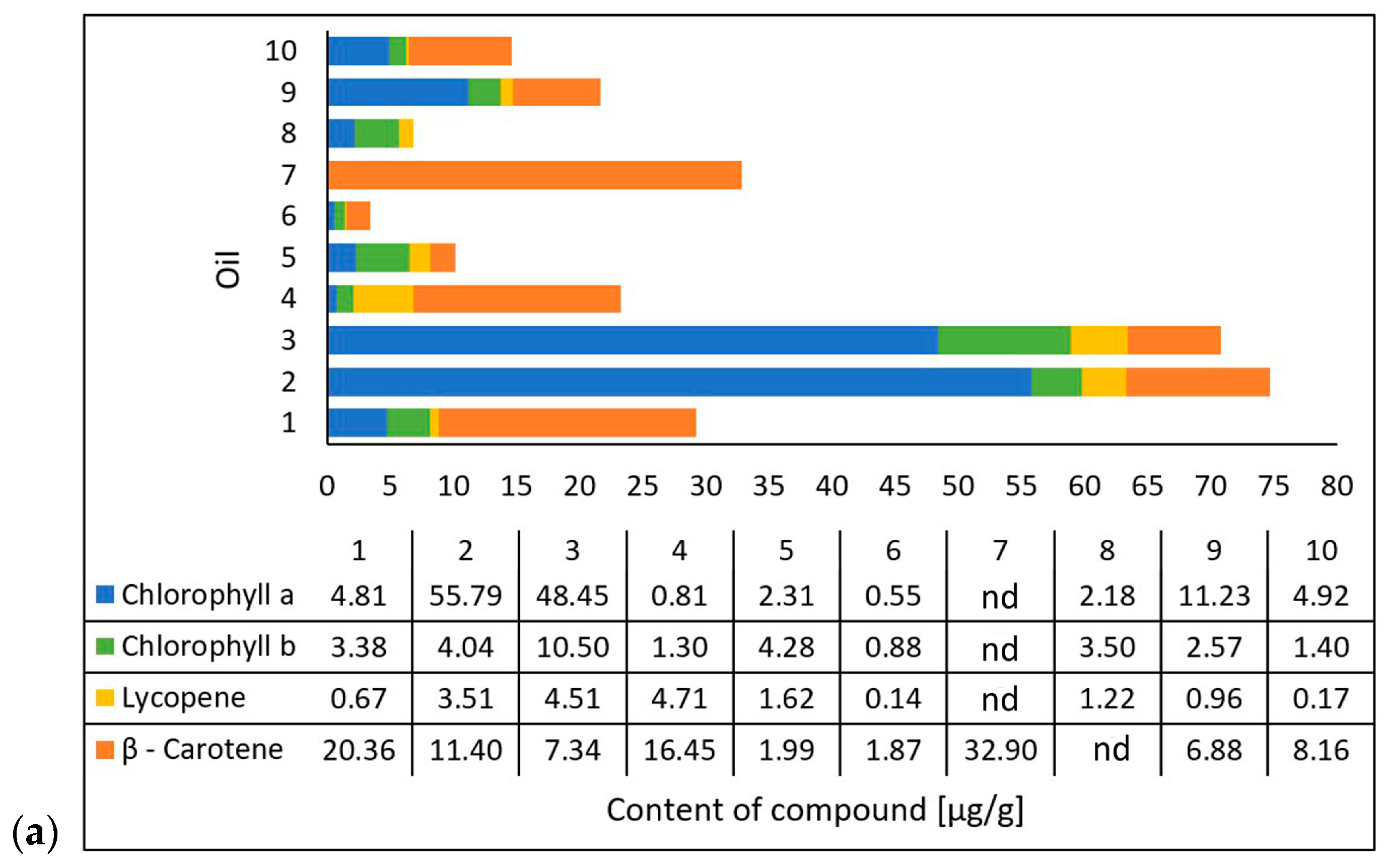
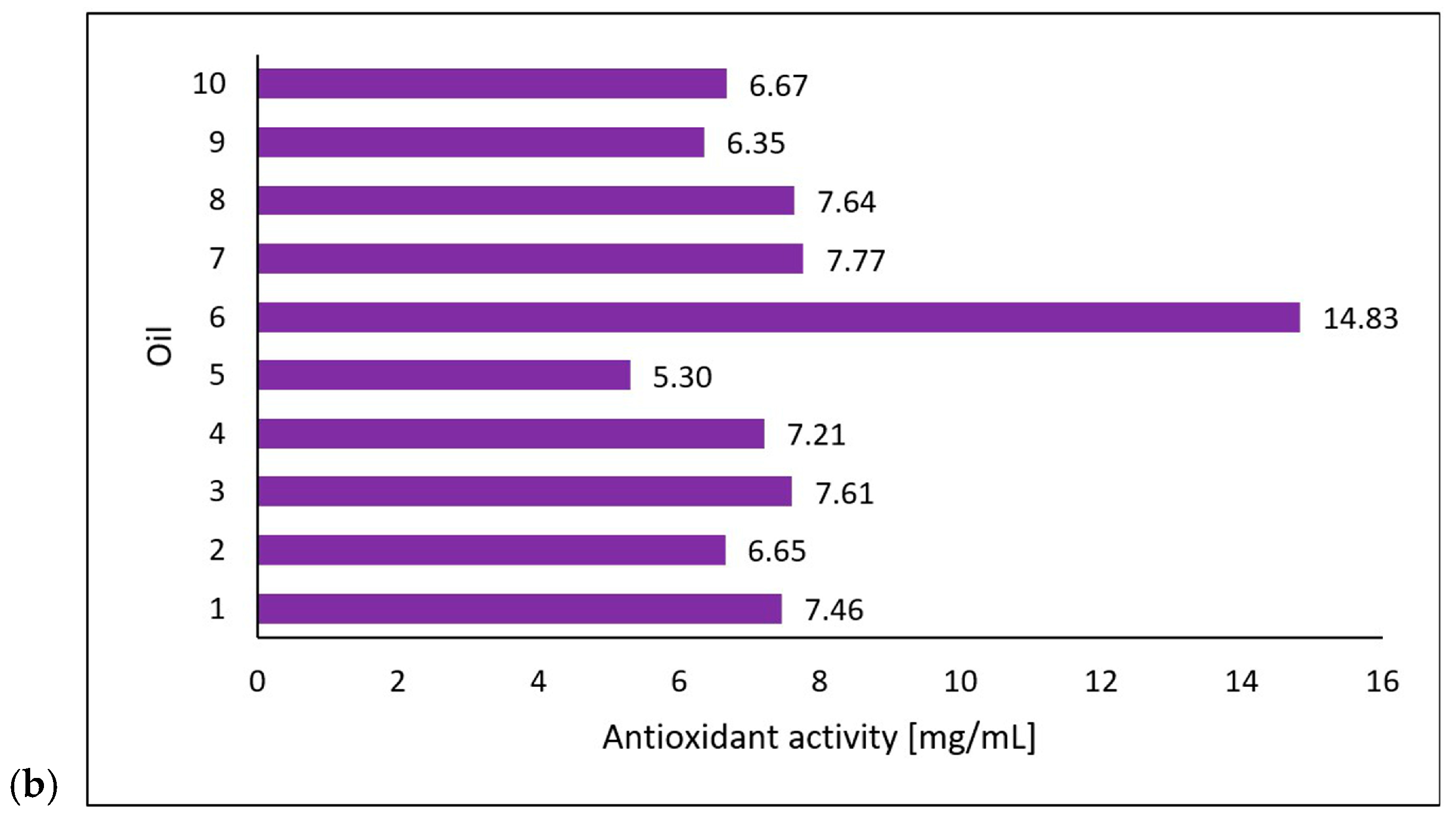

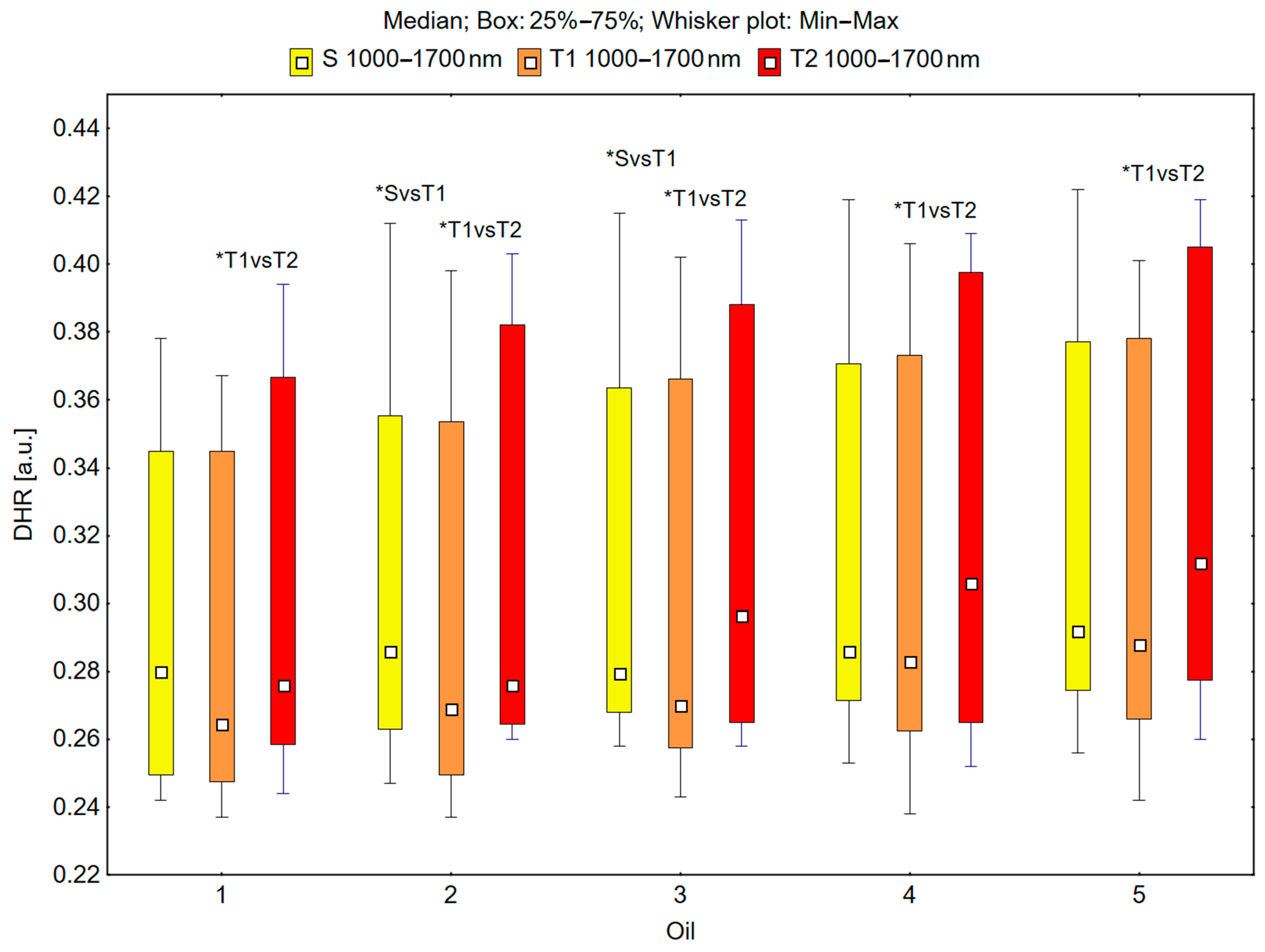
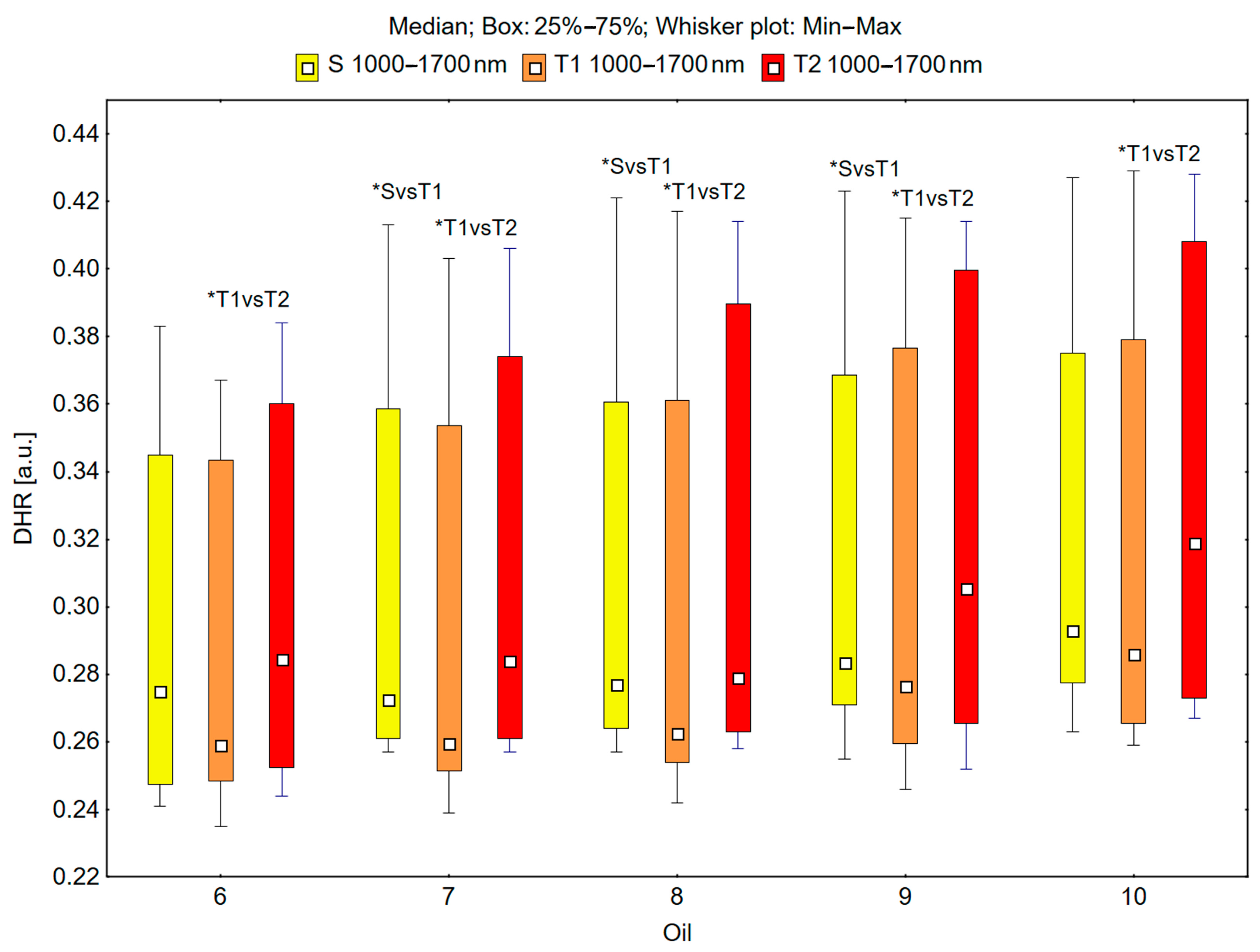
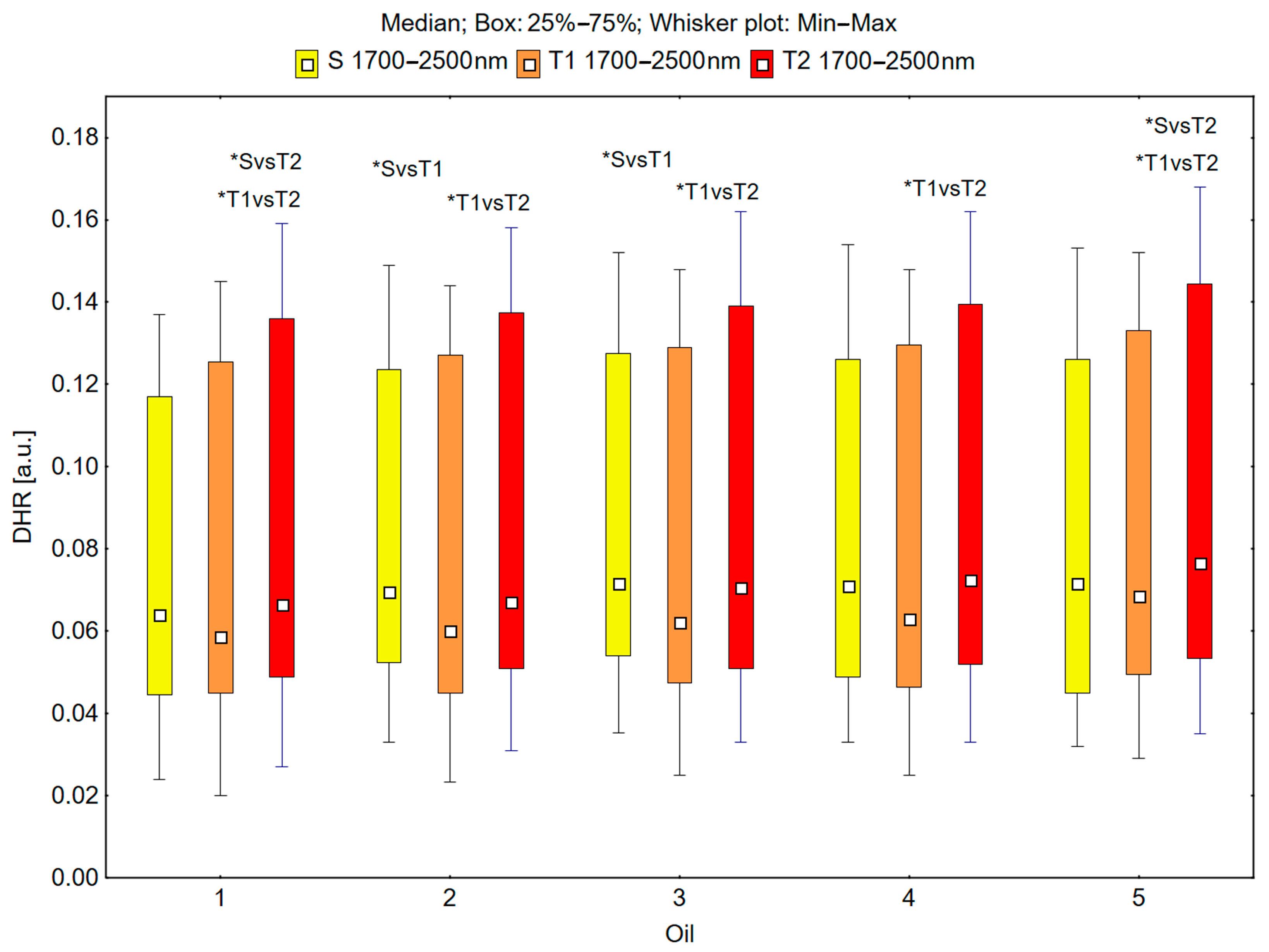

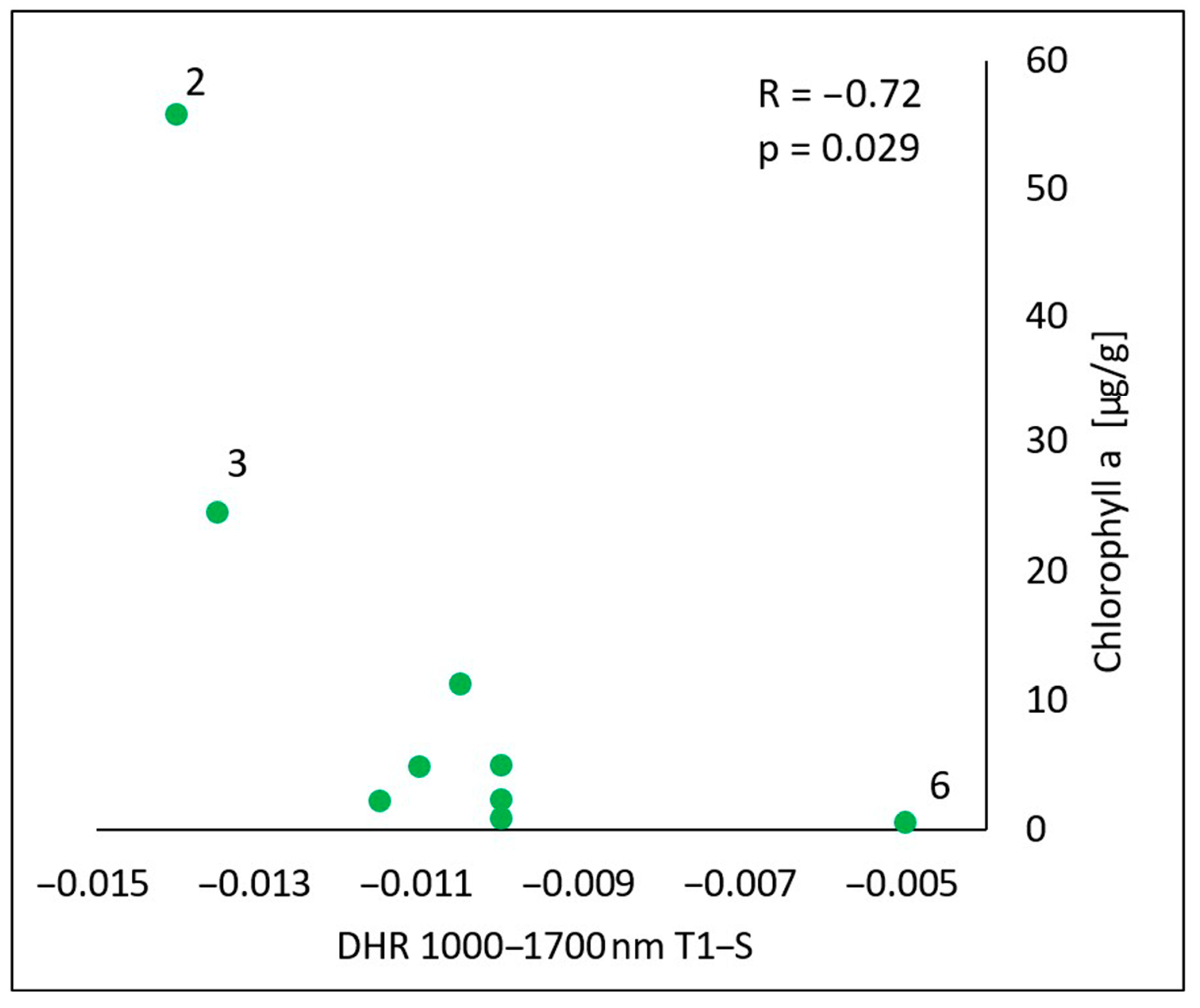
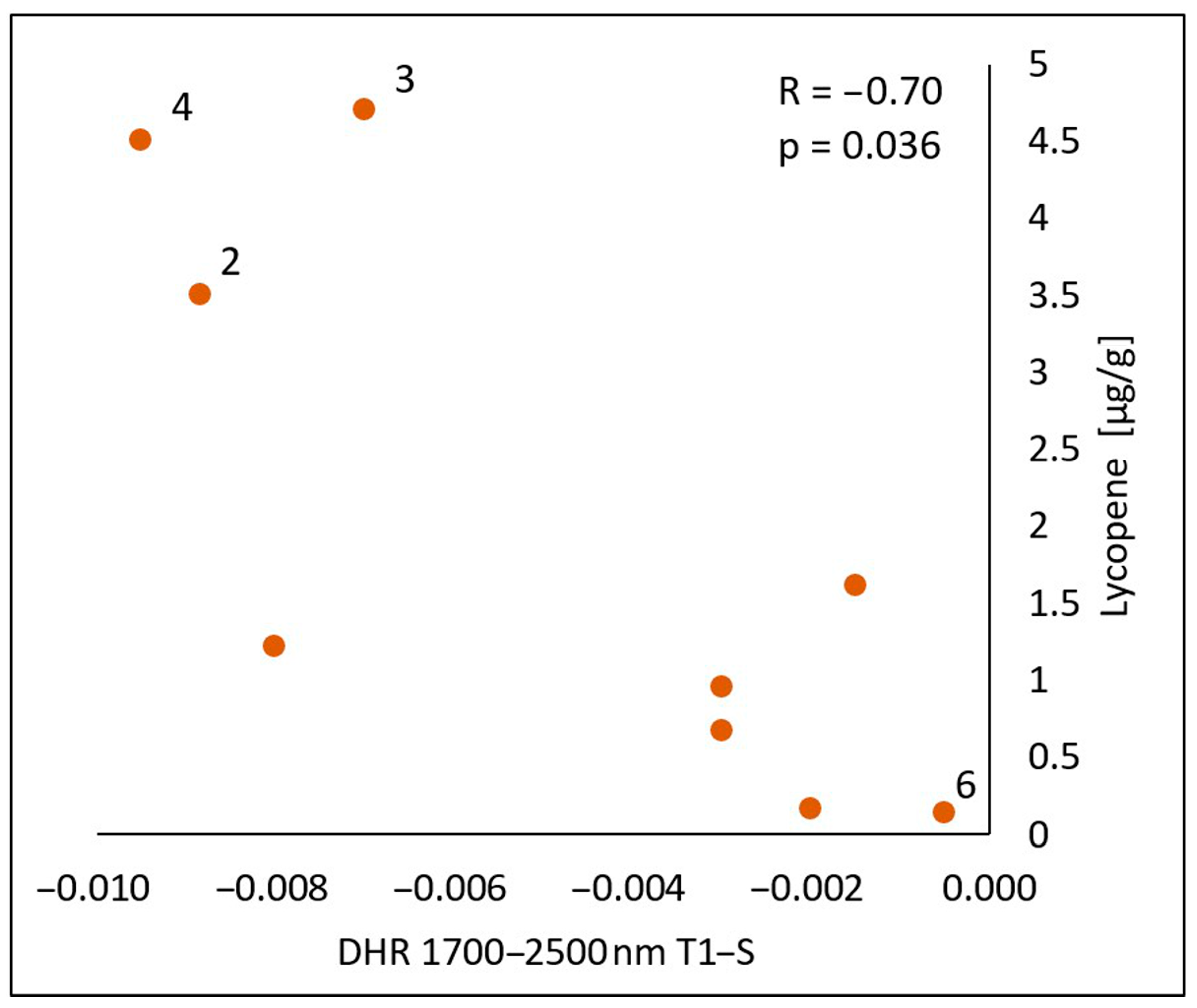
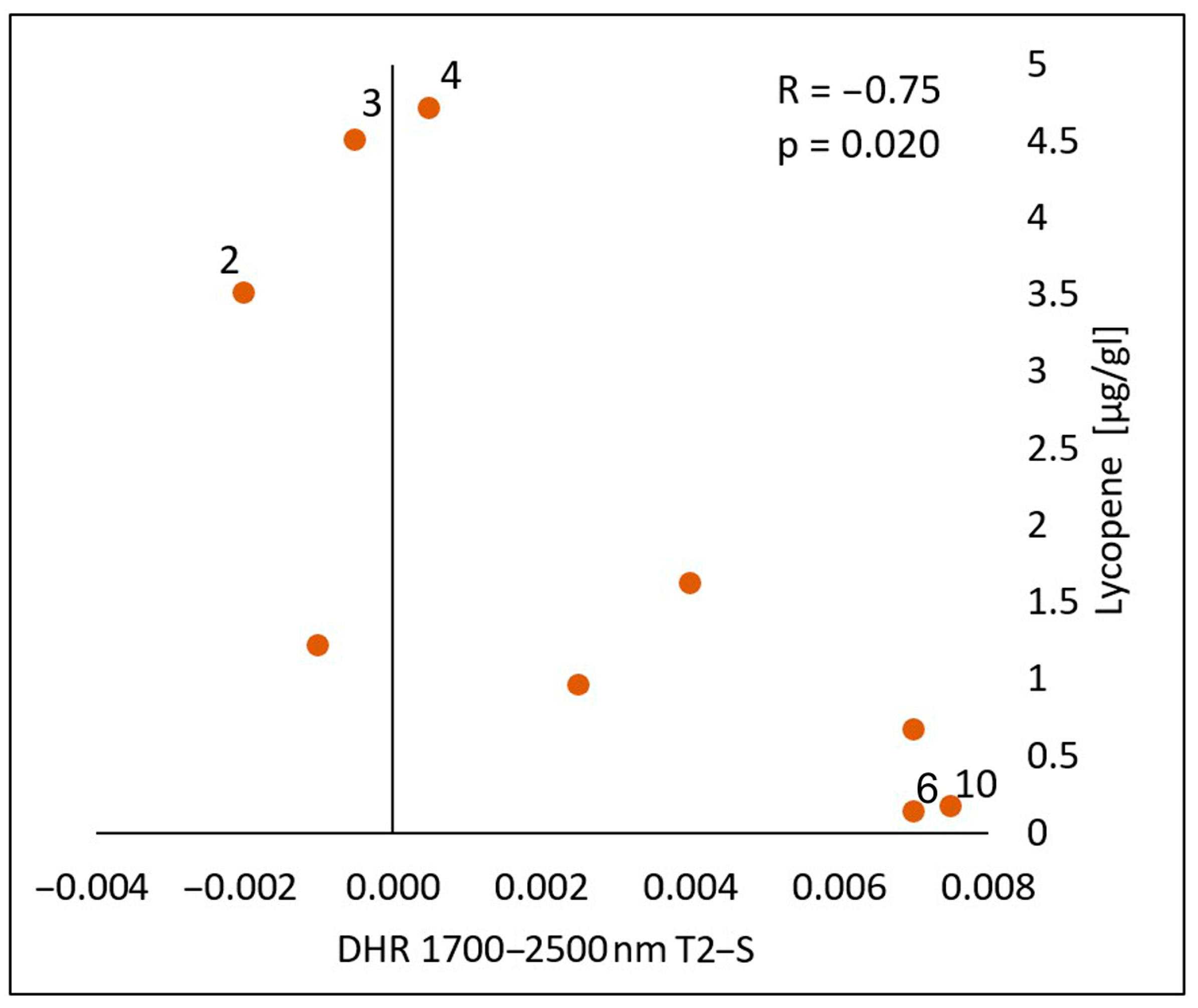
| Spectral Range | Difference | Compound | N | R | p |
|---|---|---|---|---|---|
| DHR 1000–1700 nm | T1-S | Chlorophyll a | 9 | −0.720 | 0.029 |
| Chlorophyll b | 9 | −0.611 | 0.081 | ||
| Lycopene | 9 | −0.444 | 0.232 | ||
| β-carotene | 9 | −0.234 | 0.544 | ||
| DPPH-EPR | 10 | 0.243 | 0.498 | ||
| T2-S | Chlorophyll a | 9 | −0.600 | 0.088 | |
| Chlorophyll b | 9 | −0.333 | 0.381 | ||
| Lycopene | 9 | −0.467 | 0.205 | ||
| β-carotene | 9 | −0.133 | 0.732 | ||
| DPPH-EPR | 10 | 0.321 | 0.365 | ||
| DHR 1700–2500 nm | T1-S | Chlorophyll a | 9 | −0.533 | 0.139 |
| Chlorophyll b | 9 | −0.550 | 0.125 | ||
| Lycopene | 9 | −0.700 | 0.036 | ||
| β-carotene | 9 | −0.586 | 0.097 | ||
| DPPH-EPR | 10 | −0.140 | 0.700 | ||
| T2-S | Chlorophyll a | 9 | −0.367 | 0.332 | |
| Chlorophyll b | 9 | −0.550 | 0.125 | ||
| Lycopene | 9 | −0.750 | 0.020 | ||
| β-carotene | 9 | −0.417 | 0.265 | ||
| DPPH-EPR | 10 | −0.079 | 0.829 |
Disclaimer/Publisher’s Note: The statements, opinions and data contained in all publications are solely those of the individual author(s) and contributor(s) and not of MDPI and/or the editor(s). MDPI and/or the editor(s) disclaim responsibility for any injury to people or property resulting from any ideas, methods, instructions or products referred to in the content. |
© 2025 by the authors. Licensee MDPI, Basel, Switzerland. This article is an open access article distributed under the terms and conditions of the Creative Commons Attribution (CC BY) license (https://creativecommons.org/licenses/by/4.0/).
Share and Cite
Mickoś, E.; Michalak, M.; Hartman-Petrycka, M.; Banyś, A.; Babczyńska, P.; Koprowski, R.; Wilczyński, S. Assessing Skin Photoprotection in the Infrared Range: The Reflectance Profiles of Cold-Pressed Plant Oils. Cosmetics 2025, 12, 80. https://doi.org/10.3390/cosmetics12020080
Mickoś E, Michalak M, Hartman-Petrycka M, Banyś A, Babczyńska P, Koprowski R, Wilczyński S. Assessing Skin Photoprotection in the Infrared Range: The Reflectance Profiles of Cold-Pressed Plant Oils. Cosmetics. 2025; 12(2):80. https://doi.org/10.3390/cosmetics12020080
Chicago/Turabian StyleMickoś, Elżbieta, Monika Michalak, Magdalena Hartman-Petrycka, Anna Banyś, Paula Babczyńska, Robert Koprowski, and Sławomir Wilczyński. 2025. "Assessing Skin Photoprotection in the Infrared Range: The Reflectance Profiles of Cold-Pressed Plant Oils" Cosmetics 12, no. 2: 80. https://doi.org/10.3390/cosmetics12020080
APA StyleMickoś, E., Michalak, M., Hartman-Petrycka, M., Banyś, A., Babczyńska, P., Koprowski, R., & Wilczyński, S. (2025). Assessing Skin Photoprotection in the Infrared Range: The Reflectance Profiles of Cold-Pressed Plant Oils. Cosmetics, 12(2), 80. https://doi.org/10.3390/cosmetics12020080








